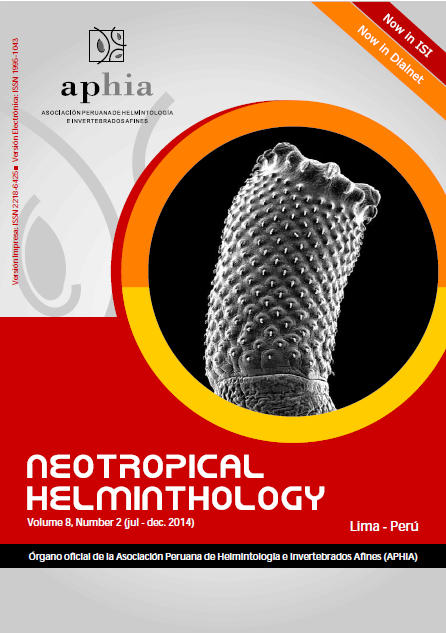HELMINTHIC ASSEMBLAGES OF SERIOLELLA POROSA GUICHENOT 1848 (PISCES: CENTROLOPHIDAE) FROM SAN MATÍAS GULF (ARGENTINA)
DOI:
https://doi.org/10.24039/rnh201482922Keywords:
Fish, helminthic assemblages, parasite ecology, Seriolella porosa.Abstract
No previous studies were carried out on aspects of the helminth assemblages of Seriolella porosa. The present study aims to analyze the metazoan parasite of S. porosa and establish the relationship between the parasitic variations and both fish size and sex. A total of 101 specimens of S. porosa from San Matías Gulf, Argentina were examined between September and October 2006. Thirteen species were reported with a total of 3366 parasites. Lecithocladium cristatum was the most prevalent, dominant and abundant species. The average species richness was 3.2 ± 1.20. The evenness showed an inverse correlation with the total number of parasites and did not reveal differences between host sexes. None of the parasite species showed interspecific associations with each other. The average richness of the infracommunity was significantly less than the component community. The helminth community of the silver warehou shows little diversity with many satellite species and only two core species (Anisakis sp. and L. cristatum). Further studies, using parasites as stock indicators, would indicate whether the San Matías population represents a reproductive aggregation that penetrates the gulf seasonally in winter or whether it is a permanent stock isolated from the continental shelf.
Downloads
Published
How to Cite
Issue
Section
License
Copyright (c) 2021 Neotropical Helminthology

This work is licensed under a Creative Commons Attribution-NonCommercial-NoDerivatives 4.0 International License.
OBJETO: El AUTOR-CEDENTE transfiere de manera TOTAL Y SIN LIMITACIÓN alguna al CESIONARIO los derechos patrimoniales que le corresponden sobre la (s) obra(s) tituladas: xxxxxxxxxxxxxxxx, por el tiempo que establezca la ley internacional. En virtud de lo anterior, se entiende que el CESIONARIO adquiere el derecho de reproducción en todas sus modalidades, incluso para inclusión audiovisual; el derecho de transformación o adaptación, comunicación pública, traducción, distribución y, en general, cualquier tipo de explotación que de las obras se pueda realizar por cualquier medio conocido o por conocer en el territorio nacional o internacional.
REMUNERACIÓN: La cesión de los derechos patrimoniales de autor que mediante este contrato se hace será a título gratuito.
CONDICIONES Y LEGITIMIDAD DE LOS DERECHOS: El AUTOR-CEDENTE garantiza que es propietario integral de los derechos de explotación de la(s) obra(s) y en consecuencia garantiza que puede contratar y transferir los derechos aquí cedidos sin ningún tipo de limitación por no tener ningún tipo de gravamen, limitación o disposición. En todo caso, responderá por cualquier reclamo que en materia de derecho de autor se pueda presentar, exonerando de cualquier responsabilidad al CESIONARIO.
LICENCIA DE ACCESO ABIERTO: El AUTOR-CEDENTE autoriza que manuscrito publicado en La Revista Neotropical Helminthology permanece disponible para su consulta pública en el sitio web https://www.neotropicalhelminthology.com/ y en los diferentes sistemas de indexación y bases de datos en las que la revista tiene visibilidad, bajo la licencia Creative Commons, en la modalidad Reconocimiento-No comercial- Sin Trabajos derivados –aprobada en Perú, y por lo tanto son de acceso abierto. De ahí que los autores dan, sin derecho a retribución económica, a la Asociación Peruana de Helmintología e Invertebrados Afines (APHIA), los derechos de autor para la edición y reproducción a través de diferentes medios de difusión.


 Numero 2 Volumen 19 - 2025 (versión Anticipada)
Numero 2 Volumen 19 - 2025 (versión Anticipada)














































